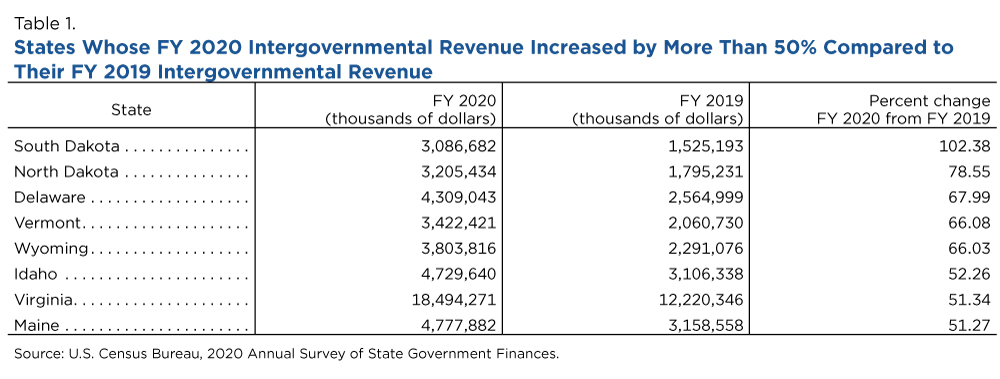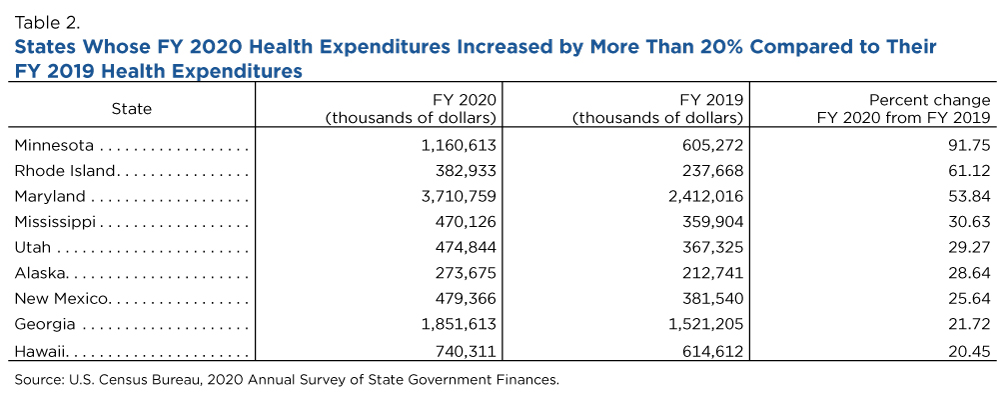2020 CARES ACT Increased Some States’ Revenues by More Than 50%
The CARES Act, passed on March 27, 2020, provided funding to state governments for COVID-19 relief for only the last three months of fiscal year 2020, but even so, it seems to have had a major impact on some states’ finances compared to 2019.
The U.S. Census Bureau’s Annual Survey of State Government Finances captures the effect of the CARES Act funding and offers a glimpse of its impact on government finances.
For example, as a result of the additional funding for April, May and June of 2020, eight states saw more than a 50% increase in government funding. Nine states increased health expenditures by more than 20%, three of them by more than 50%.
The typical fiscal calendar runs from July 1 to June 30. For the purposes of this story, the four states that follow a different fiscal calendar — Alabama, Michigan, New York and Texas — are excluded.
California is also excluded because the Census Bureau does not receive annual data from that state. Instead, the Census Bureau uses California’s budget documents that do not reflect this additional federal income as of the publication of this story.
Although the latest Annual Survey of State Government Finances covers only the first three months of the CARES Act (March 27-June 30, 2020), the data show the potential impact it had on government finances.
Total expenditures for the states in the study were $1.7 trillion in 2020 compared to $1.6 trillion in 2019, an 8.73% increase.
About the CARES Act
The Coronavirus Aid, Relief, and Economic Security Act (CARES Act) provides over $2 trillion of economic relief to workers, families, small businesses, industry sectors and other levels of government that were hit hard by the public health crisis created by the coronavirus pandemic.
Title V of the CARES Act established the Coronavirus Relief Fund for the purpose of providing $150 billion in direct assistance to states, units of local government, the District of Columbia, U.S. territories and tribal governments.
U.S. State Revenues and Expenditures: FY 2020 and 2019
For the states included in this story, excluding Alabama, California, Michigan, New York and Texas, state government general revenues totaled $1.5 trillion in 2020 compared to $1.4 trillion in 2019, an increase of 6.67%.
However, intergovernmental revenues — which includes federal funding — accounts for more than one-third (36.77%) of state government general revenues at $566.2 billion in 2020. That’s an increase of 24.45% from the 2019 estimate of $454.9 billion in intergovernmental revenues.
Total expenditures for the states in the study were $1.7 trillion in 2020 compared to $1.6 trillion in 2019, an 8.73% increase.
State Comparisons: 2020 to 2019
To determine the potential impact of CARES funding on U.S. states, we look at three categories and compare the differences (for the states included) between FY 2020 and FY 2019: intergovernmental revenue, health expenditures and hospital expenditures.
- Intergovernmental revenue refers to the amounts that states receive from other governments, including the federal government. It includes shared revenues, grants-in-aid and reimbursements. It excludes the amounts received from other governments for sale of property, commodities and utility services.
In FY 2020, for the states included, the national increase in intergovernmental revenue from FY 2019 was 24.45%. However, eight states saw an increase of more than 50%: South Dakota, North Dakota, Delaware, Vermont, Wyoming, Idaho, Virginia and Maine.

- Health includes outpatient health services (other than hospital care), as well as public health administration, research and education, treatment and immunization clinics, and nursing. It also includes environmental health activities such as air and water pollution control, ambulance service if provided separately from fire protection services, and school health services.
In FY 2020, for the states included, the national increase in health expenditures from FY 2019 was 12.25%. However, nine states saw an increase of more than 20%: Minnesota, Rhode Island, Maryland, Mississippi, Utah, Alaska, New Mexico, Georgia and Hawaii.

- Hospitals includes the financing, construction acquisition, maintenance or operation of hospital facilities, provision of hospital care, and support of public or private hospitals.
In FY 2020, for the states included, the national increase in hospital expenditures from FY 2019 was 7.54%. However, six states saw an increase of more than 13%: Arizona, South Carolina, Wyoming, Alaska, Washington, and Arkansas.

Related Statistics
-
Stats for StoriesPublic Service Recognition Week: May 7-13, 2023The 2021 Annual Survey of Public Employment & Payroll counted 14.9M full-time and 4.0M part-time employees working in state and local government in the U.S.
-
Annual Survey of State and Local Government Finances (ALFIN)Statistics on revenue, expenditure, debt, and assets (cash and security holdings) for governments.
Subscribe
Our email newsletter is sent out on the day we publish a story. Get an alert directly in your inbox to read, share and blog about our newest stories.
Contact our Public Information Office for media inquiries or interviews.
-
America Counts StoryWho Is Receiving Social Safety Net Benefits?May 24, 2022A new data tool allows users to explore thousands of social safety statistics 2013-2019 and demographic and socioeconomic characteristics of recipients.
-
America Counts StoryPublic Spending on Protecting the Environment UpJune 07, 2021The Census Bureau’s Annual Survey of State and Local Government Finances shows spending on protection of natural resources has steadily increased since 2014.
-
America Counts StoryHow Much Is Your State Spending on You?May 30, 2018A new Census Bureau tool lets you see and compare how much your state and local governments are spending on programs — from public safety to schools.
-
PopulationWhich States Had the Highest Shares of Newcomers?April 29, 2025Many states with the highest share of recent movers from out-of-state in 2023 had relatively small populations.
-
Business and EconomyEntertainment, Travel, and Recreation Industries ReboundingApril 23, 2025A look at which selected travel, entertainment and recreation-related industries hit hard by the pandemic rebounded.
-
Income and PovertyNew Snapshots From the Survey of Income and Program ParticipationApril 21, 2025New Census Bureau product offers mobile-friendly fact sheets on who receives income from various sources.
-
PopulationU.S. Metro Areas Experienced Population Growth Between 2023 and 2024April 17, 2025New Census Bureau population estimates show 88% of U.S. metro areas gained population between 2023 and 2024.






